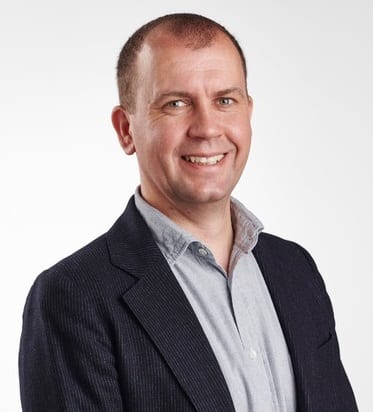|
Getting your Trinity Audio player ready...
|
Future’s Chris Convey talks to Mary Hogarth about the company’s rapid reversal of fortune and the secret of a successful acquisition.
Future plc has achieved phenomenal growth in the past few years with its acquisition strategy, seemingly playing a pivotal role in reversing the company’s fortunes. Now the media giant is poised to take over TI Media.

But what makes Future so successful? Prudent investment and a pro-active approach seem to have been a critical factor. Senior Vice President and Managing Director of Future’s B2B portfolio, Chris Convey, was at the forefront of developing its core acquisitions strategy. This proactive approach began to take shape when the company underwent a dramatic restructuring in 2014 to turn around its failing business.
As part of the reorganisation Future sold off auto, sport and craft titles. It was a tough time, admits Chris. “When I joined, the share price was about 7p or 8p, but Future feels at a different place now.”
Indeed it is. The stock price has since rocketed, peaking in January at around 1,558.00 but in recent weeks it has sharply declined, although such a fall is likely due to the global economic crisis caused by Covid19.
Growing organically
Restructuring meant that the priority was getting the business back on an even keel, then focussing on how to improve the situation.
“We began looking to grow organically and then adding complementary acquisitions,” explains Chris. “It probably was around 12 to 18 months later that we started making the first steps along what has been a fairly continual path.”
That path has seen the business undergo a dramatic transformation meaning the size and scale of deals the team is now able to do has changed the dialogue substantially.
From my perspective, focussing on acquisitions at a time of uncertainty was indeed a brave move. However, purchasing was only a part of the overall strategy, which was initially to consolidate then grow. “We have pursued that approach through different means both through organic growth and acquisition, so the latter is only one of our routes to executing that strategy.”
It is a plan that has yielded significant growth over the past five years. Last year that organic growth was around 11%. However, Chris acknowledges that this figure includes a decline across the magazines as well as significant digital growth.
But how does Future define organic growth? Chris defines it as expanding current brands, those that Future has owned for more than 12 months and developing new titles. “It is about moving into adjacencies, driving revenue streams and new launches adding extensions to those that we’ve developed in-house and haven’t had anything to do with an acquisition.”
Gaining new territories
Future’s overall objective was to diversify, which it has done geographically by moving into new markets, territories and verticals. Acquisitions have played a critical part of that diversification by facilitating expansion into new territories.
In the past five years, this international publishing company has acquired the technology platform and publisher Purch for US$132.5m and the information and events business, NewBay Media for US$13.8m. More recently it has bought the B2B digital publisher, SmartBrief for around US$65m.
All of which has helped the former UK-centric company migrate. Today, more than 50 per cent of its revenue now comes from the States.
The decision to also move into new verticals has opened up access to a broader range of markets and revenue streams. “Our home-interest acquisition, Centaur, gave us a new vertical while also significantly increasing our events portfolio and diversifying revenue streams.”
So what aspects does Future look for when seeking new acquisitions?
“Ones that help to accelerate our organic growth,” says Chris, adding that Purch is a perfect example of that.
“Consumer technology has always been our heartland. We have diversified the business, now tech represents less than a third of our revenue, but it is our biggest vertical and a powerhouse for us. We had organically grown to become number one in the UK through TechRadar. Then the Purch acquisition helped propel us further. Acquisitions have helped us accelerate, but it was the underlying organic business model that has got us where we wanted to be.”
Chris – who has now moved across to run the B2B group – admits his role in acquisitions was one that continually evolved. “My primary role was taking the overall corporate strategy, looking at what we can deliver organically, then identifying how do we transact and end up with the right acquisitions basket to fill gaps. Predominantly I was building our capability so that we could identify the right purchases that would dovetail into our overall business strategy.”
He explains that a vital part of Future’s success was that the management team had an overall strategy as well as a vision of where they wanted to go. “We knew where we wanted to take the business,” says Chris, explaining that he built in core functionality, detailing how to effectively and efficiently manage the process of identifying the right potential opportunities that could fill gaps in the company’s portfolio.
Although the process has become more complicated following its dynamic growth spurt, Future now has a clear management funnel process. First the team explores opportunities that might be of interest, then distils those down to ones that they actually want to consider.
“Ultimately, we only investigate those that are most likely to fit with Future in terms of operating model, culture and the value that we can we can unlock together.”
Once likely acquisitions have been identified, a process of detailed investigation and diligence follows before the transaction takes place. One of Future’s notable UK purchases was four prominent tiles from Haymarket Media Group in 2018 when it acquired FourFourTwo, Practical Caravan, Practical Motorhome and WHAT H-FI? for £13m.

Why those titles? “It was an interesting basket of brands that facilitated different opportunities. WHAT HI-FI? was a natural fit with Tech Radar. Although they covered similar ground, WHAT HI-FI? was very deep in the areas that TechRadar wasn’t and vice versa. In that space, we saw – and are now pleased to be realising – growth opportunities around the eCommerce side.”
Lessons learned
Having amassed some critical lessons during his time with Future, Chris reflects that the most important is that no two deals are ever the same – and you have to be humble.
“You can’t walk in there and assume you do it right and they don’t,” he says adding that their team often assumes that everybody else does it better than Future.
Achieving value is also crucial. In this respect, he advises taking an analytical approach to maximising value once both businesses have been combined, then adopting best practices from each.
“You need to be very non-tribal in what best is and look at what is the right thing to do moving forward,” he says citing the Purch acquisition as an excellent example of this. “We ended up with a new programmatic advertising model which we called hybrid because it is a fusion of the historic Future ad stack and the Purch one. By combining the two and building something new, we took the best of both worlds and improved our yield.
“It is about recognising that you don’t always know best. Taking the opportunity to learn and moving forward with the best of the best.”
But acquisitions are also about people, something Chris has realised more and more. “There are so many things that you have to be aware of such as not assuming that because somebody has got the same job title in a different organization doesn’t mean that they do the same job. A critical part of an acquisition is to spend a lot of time understanding in detail what exactly people do.”
He also points out that organisations have many cultural differences and speak different languages. “We’re very technology and data-driven so we tend to talk a certain way in our business, but not all businesses are the same. It is important to listen carefully to how other people are saying things and make sure you understand.”
Moving forward
How will magazines evolve in the next decade? From Chris’s perspective, there is always going to be a place in the market for specialist content and magazines as “people will always want to engage with good content.”
However, he thinks the future of magazines will very much depend on how people want to consume that content, which is why Future is heavily invested in evolving and understanding people’s consumption habits.
“Maintaining flexibility in delivery and in what you are producing so that it is totally relevant to your audience, is vital. Fundamentally, if you have good content that people are interested in reading and they value, then that should survive.”
While content and data are at the heart of this publishing business, it is clear that their audience’s needs have always taken precedence. “We can connect people with content that helps to enrich their lives – be that either on the consumer or B2B side. How that information or content is consumed – be it online or an event or through print – will probably change. Our diversification strategy means that we can provide that insight to our readers/consumers regardless of how they choose to access it.”
Fulfilling the needs of their consumers is a critical part of Future’s forward vision. That multi-channel audience-centric focus – allowing the audience to interact regardless of how they choose to do that – could well set them apart from competitors.
Mary’s verdict
Continual learning, pushing boundaries through acquisitions and organic growth have been pivotal factors in Future’s route to success. I have always had faith in Future, despite the share price indicating otherwise. Is this because of its innovative and vibrant ethos that lay at the heart of its corporate culture?
Perhaps, but mostly it is Future’s high regard for editorial excellence – whether that best practice is in-house or elsewhere.



